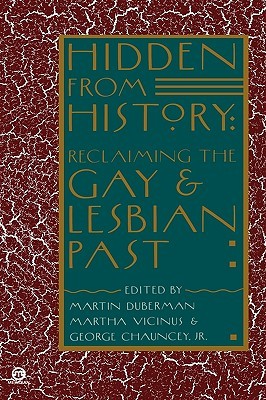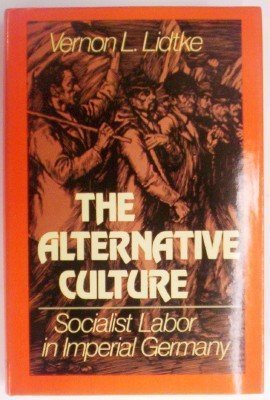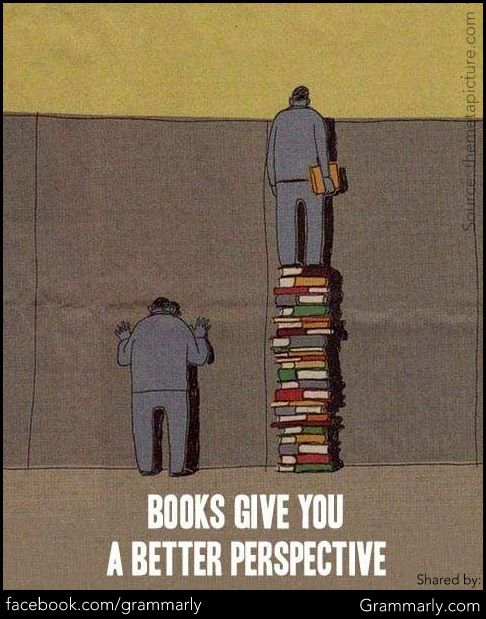Duberman, Martin, Martha Vicinus, and George Chauncey, Jr., eds. Hidden from History: Reclaiming the Gay & Lesbian Past. New York: Meridian, 1989.
Subject: An anthology of 29 essays on gay and lesbian history, from the ancient world to the post-World War II era.
Summary & Main Points from the Introduction: The introduction is actually a helpful, if brief, historiographical essay on the main trends of the study of homosexuality in the past 150 years. I don’t want to summarize it all here, but I do want to point out the two developments that the editors believe have led to an “unprecedented outpouring” of work done on gay and lesbian history since the 1970s. First has been the success of a lesbian and gay movement in creating a more tolerant climate in which scholarship could be done. They also note that activists – like Jonathan Katz – were among the first to do this research. The second development has been a change in the notions of what constitutes acceptable topics for researchers. LGBT topics and sexuality and gender have been “approved” as part of a larger movement that made social history acceptable.
After scholars began reclaiming (or “finding”) the “gays and lesbians” in the past, they started focusing on specific themes: the oppression of homosexuality through politics, morals, and through pathologization. Some scholars, though, began focusing on the oppressed subcultures themselves and the way that they resisted oppression.
The introduction then summarizes the impact of social constructionism on our understanding of (homo)sexuality, though Carole Vance warned against the “oversimplified and undifferentiated use of the theory,” insisting that just because the modern homosexual or “gay” person didn’t exist in the past, we should not deduce that no type of identity based around homosexual acts ever existed. In other words, “Most recent work argues that the homosexual role, as we currently think of it, developed only in the modern period, but it also establishes that the modern role is not the only homosexual role possible” (9).
The most interesting part of the introduction – and the most helpful for me in my research – is when the editors discuss the “unusually” close relationship between professional historians, gay rights activism, and a collective identity. “The gay and lesbian communities have increasingly recognized that some of the most important issues facing, agitating, and sometimes dividing them today, personally and collectively, are best addressed historically” (11). Because their past has been ignored or denied, gay people’s “hunger for knowledge of their past is strong. Having struggled to create a public presence for themselves in the world today, they seek to reclaim their historical presence. For many, gay history helps constitute the gay community by giving it a tradition, helps women and men validate and understand who they are by showing them who they have been” (12).
Selection of essays from the book:
Robert Padgug, “Sexual Matters: Rethinking Sexuality in History”
Denying that the categories of sexual behavior currently familiar to us (hetero/homosexual) are predetermined and universal, Padgug argues that our sexuality is neither a fixed essence nor even, necessarily, an individual’s innermost realit. To the contrary, human sexuality, unlike animal sexuality, is never more than a “set of potentialities,” rich and ever-varying, tied above all to whatever is currently viewed as social reality. Just as social reality changes radically through time, so do the sexual categories that reflect it.
Vivien W. Ng, “Homosexuality and the State in Late Imperial China”
In the seventeenth century, China experienced a burst of public interest in male homosexuality. Confucian scholars made references to it in their jottings, and novelists and playwrights celebrated it in their works. This open discussion of homosexuality led to a conservative backlash by the new Manchu rulers of the new Qing dynasty. Responding to the widespread perception that homosexuality had become “rampant” in China, the Qing government, in 1740, decreed that consensual sodomy between adults was a punishable offense. Ng’s essay first establishes the social milieu of seventeenth-century China, then explores descriptions of homosexual love in literature and the relations of such descriptions to Confucian ideology, and finally, analyzes the response o Chinese officialdom.
Randolph Trumbach, “The Birth of the Queen: Sodomy and the Emergence o Gender Equality in Modern Culture, 1660-1750”
Trumbach argues that a major shift occurred in the conventions governing male homosexual relations in Europe’s large cities around 1700. Whereas before then, many citizens of cities such as London accepted the existence of adult male “rakes” who had sex with both women and boys, after 1700 they were increasingly likely to think of homosexual behavior as the forbidden activity of a deviant, effeminate minority of adult males. Groups of such men actually appeared about then, and were best known because of raids on the “molly houses” where they gathered. Trumbach argues that their emergence should be understood in the context of a growing gender equality between men and women (equality in the new, heterosexual norm, with the deviant being “the other.”)
James D. Steakley, “Iconography of a Scandal: Political Cartoons and the Eulenburg Affair in Wilhelmin Germany”
From 1907 to 1909, Imperial Germany was rocked by a series of courts-martial concerned with homosexual conduct in the army as well as five courtroom trials that turned on the homosexuality of prominent members of Kaiser Wilhelm II’s entourage and cabinet. National honor was palpably at stake in the Eulenburg Affair, as it had come to be known. While it was unfolding, the scandal led to an unprecedentedly detailed discussion homosexual practices in the German and even foreign press, including a wealth of (anti-)gay images in political cartoons. These representations provide vivid insights into the nation’s values, anxieties, and cultural norms, revealing that homophobia was yoked with anti-Semitism and antifeminism as part of a broader antimodernist backlash that ultimately led to Germany’s entry into WWI. Yet, at the same time, increased public awareness of homosexuality undoubtedly caused some individuals to reconceptualize their sexual activities and thus contributed to the making of modern homosexuals.
George Chauncey, Jr., “Christian Brotherhood or Sexual Perversion? Homosexual Identities and the Construction of Sexual Boundaries in the World War I Era”
Using evidence generated by a navy investigation of homosexuality at the Newport Naval Training Station in 1919-1920, Chauncey reconstructs the social organization and self-understanding of homosexually active sailors. Newport’s sexual culture was surprisingly different from our own, and Chauncey shows how large numbers of sailors were able to have sex with men identified as “queers” without its affecting their image of themselves as “normal” men. This is due to a highly developed and varied gay subculture in which multiple identities (queer, fairy, trade, etc) could allow some men – usually playing the dominant and masculine roll – could have sex men (of another category) without becoming “a homosexual” themselves. Also striking is his analysis of the relative insignificance of medical discourse in shaping homosexual identities, the class differences in sexual ideology, and the diversity of sexual cultures.
Erwin Haeberle, “Swastika, Pink Traingle, and Yellow Star: the Destruction of Sexology and the Persecution of Homosexuals in Nazi Germany”
This one is particularly central to my own research, though it wasn’t particularly enlightening. Haeberle shows how several forms of discrimination culminated in Magnus Hirschfeld: he was Jewish, homosexual, and a socialist. His work in sexology put yet another target on his back, because Haeberle argues that sexology was focused primarily on critiquing the prevailing sexual attitudes and traditional assumptions about sex (while the Nazis were trying to re-implement traditional roles). His discussion of the actual persecution of homosexuals is rather accurate – though he admits that activists and early historians who didn’t have access to Third Reich records produced an exaggerated narrative. Yet, he also falls in the trap of taking the Nazis at their word. He presents statements from the Party about their views on homosexuality, without actually examining what was happening on the ground. So, while this is a good start for this research, it needs to be taken further (which is what I intend to do!)
John D’Emilio, “Gay Politics and Community in San Francisco since World War II
In this essay, he picks up a tradition of community history by focusing on San Francisco, a city especially identified with the gay experience. He explains how San Fran became a “gay space” – one reason being men and women discharged from the military for homosexuality did not want to return home to face the stigma, so they stayed and helped contribute to a forming community. He adds that the repression of the postwar decade heightened consciousness of belonging to a group. D’Emilio makes it clear that the emergence of San Francisco as a gay space, and eventually as a hotbed of gay activism can only be understood in lieu of larger social changes at the time. San Francisco was home to other radical movement, like the beat/hippies, as well as a literary tradition that questioned traditional moral values. Gays and lesbians felt more at home in this liberal atmosphere. As the community grew, the consciousness of community led to political activism, and the activists borrowed from the women’s lib, black power, and civil rights movements. Backlash from the New Right provided the stimulus of the potential of the politically active gays and lesbians (which were just a minority of the gay and lesbian community) into a force with real power.
My Comments:
Overall, I think it’s a helpful book, and there definitely needed to be an anthology of gay and lesbian history by 1990. The introduction is helpful in tracing the major trends in the field, and each of the essays raise important questions about essentialism vs. constructionism and the relationship between medical knowledge, sexuality, and politics.
Unfortunately, this is a very male-dominated book. It was also a very Western book. It would have been greatly improved if there was more work dedicated to the unique lesbian experience, as well as the multiple different ways in which same-sex desire has been understood in non-Western societies.
For more books on the history of sexuality, see my list of reviews, HERE.






















